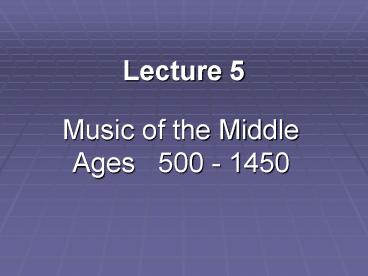Music of the Middle Ages 500 1450 PowerPoint PPT Presentation
1 / 14
Title: Music of the Middle Ages 500 1450
1
Lecture 5
- Music of the Middle Ages 500 - 1450
2
Music of the Middle Ages 500 - 1450
- SACRED MUSIC
- GREGORIAN CHANT
- Monophonic song with Latin text
- Syllabic
- Neumatic
- Melismatic
- Neumes
- Modes
- Scale patterns
3
Music of the Middle Ages 500 - 1450
- Sacred Music
- The Mass - The most solemn ritual of the Roman
Catholic Church - Proper - liturgy that changes for each
celebration - Ordinary - liturgy that remains the same for each
celebration - Music - each section of the mass has chants
associated with them
4
Music of the Middle Ages 500 - 1450
- Sacred Music
- The Music of Hildegard of Bingen (1098-1179)
- Alleluia, O virga mediatrix
- Alleluia from the Proper of the Mass
- Poem in honor of the Virgin Mary
- Monophonic texture
- Responsorial form
- melismatic and neumatic style
5
Music of the Middle AgesHildegard of Bingen
Alleluia, O virga mediatrixListening
- Melody - conjunct
- Rhythm - nonmetric
- Harmony - NA
- Texture - Monophony- Responsorial solo/chorus
- Form - chorus verse chorus
- Expression - NA
- Instrumentation - voices
6
Music of the Middle Ages 500 - 1450
- Sacred Music - The Rise of Polyphony
- The Notre Dame School (c. 1175)
- Organum
- Earliest genre in polyphonic texture
- A new voice (melody) added over a preexisting
Gregorian chant - Leonin and Perotin
- Required development of rhythm and meter
- Notation
7
Music of the Middle Ages Gothic Era
- Sacred Music - The Rise of Polyphony
- The Notre Dame School (c. 1200)
- Organum
- Gaude Maria virgo - Perotin?
- 3 voiced
- Based on chant melody
- Upper voices are called Countermelody
8
Music of the Middle AgesGaude Maria
virgoListening
- Melody - conjunct
- Rhythm - triple meter (long short short pattern)
- Harmony - modal w/open chords at cadences
- Texture - Polyphony
- Form - binary - Shifting from organum to chant
(AB) - Expression - NA
- Instrumentation - 2 voices instrument?
9
Music of the Middle Ages
- Sacred Music - The Rise of Polyphony
- The Medieval Motet (late 13th Century)
- Multi-voiced organum with new texts added to
upper voices - Polytextual - may be in French as well as Latin
and often concerning differing subjects!
10
Music of the Middle Ages 500 - 1450
- Secular Music
- Minstrelsy (12th and 13th Centuries)
- Minstrels - class of itinerant musicians and
entertainers who traveled from town to town - Upper class poet/musicians
- Troubadours - Southern France
- Trouveres - Northern France
- Monophonic songs in vernacular
- Texts usually about idealized love
11
Music of the Middle Ages Late Middle Ages
- Secular Music - French Ars Nova - 14th Century
- Chanson - polyphonic songs in vernacular (French)
- Guillaume de Machaut (c. 1300-1377)
- Puis quen oubli
- 3 voiced polyphonic texture
- Fixed forms
- rondeau, ballade, virelai
12
Music of the Middle AgesGuillaume de Machaut
Puis quen oubliListening
- Melody - conjunct
- Rhythm - triple meter
- Harmony - minor modality w/open chords at
cadences - Texture - 3 voiced Polyphony
- Form - fixed form rondeau verse/chorus (refrain)
- Expression - slow tempo
- Instrumentation - 3 mens voices
13
Music of the Middle Ages Late Middle Ages
- Secular Music - Instrumental Music
- Royal Estampie
- (14th century)
14
Reading Assignment
- chapters 14 - 16

